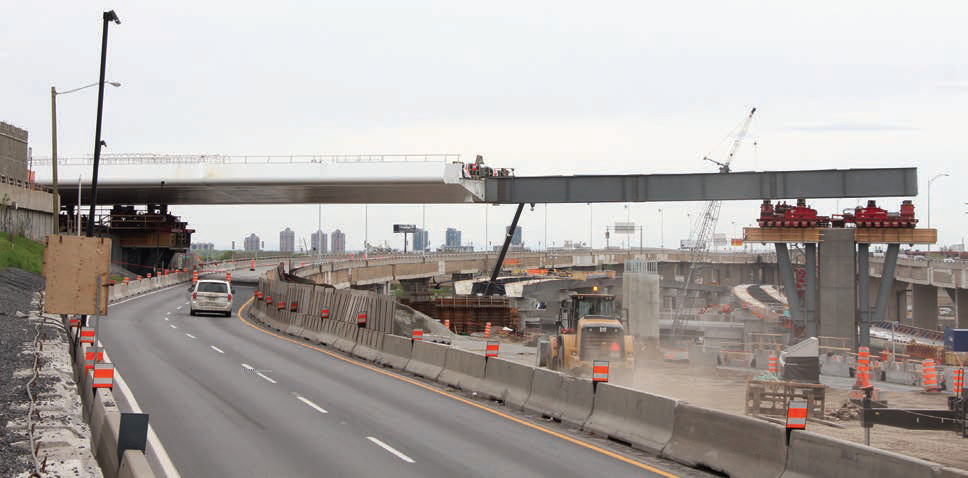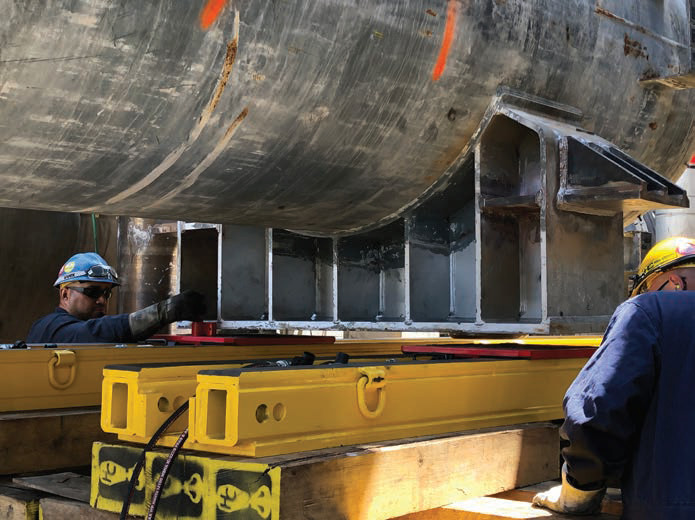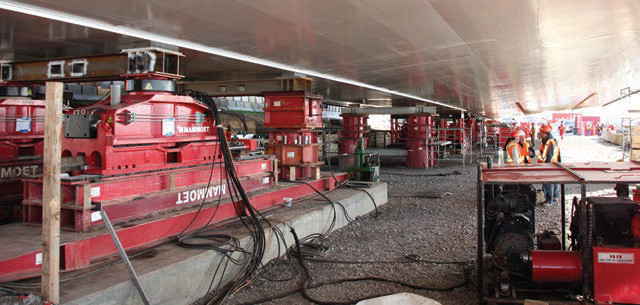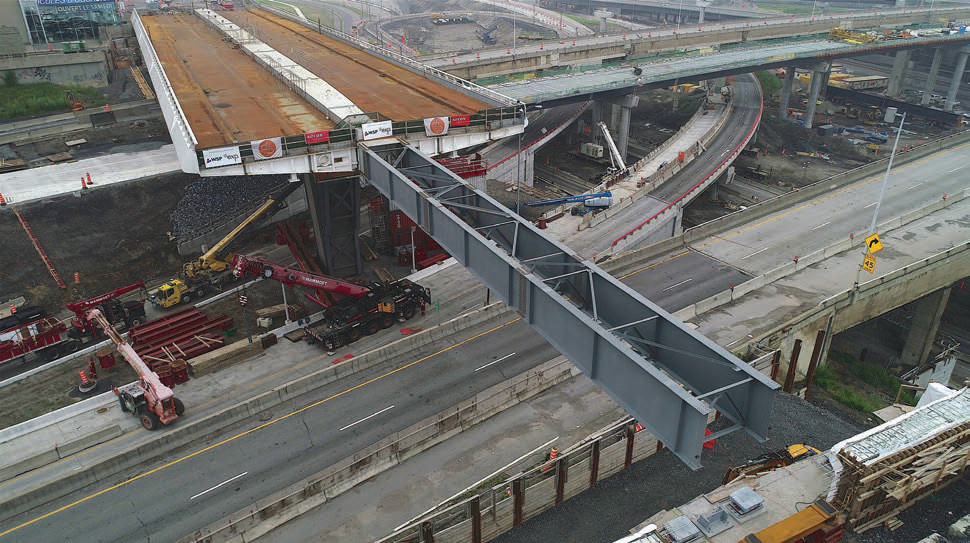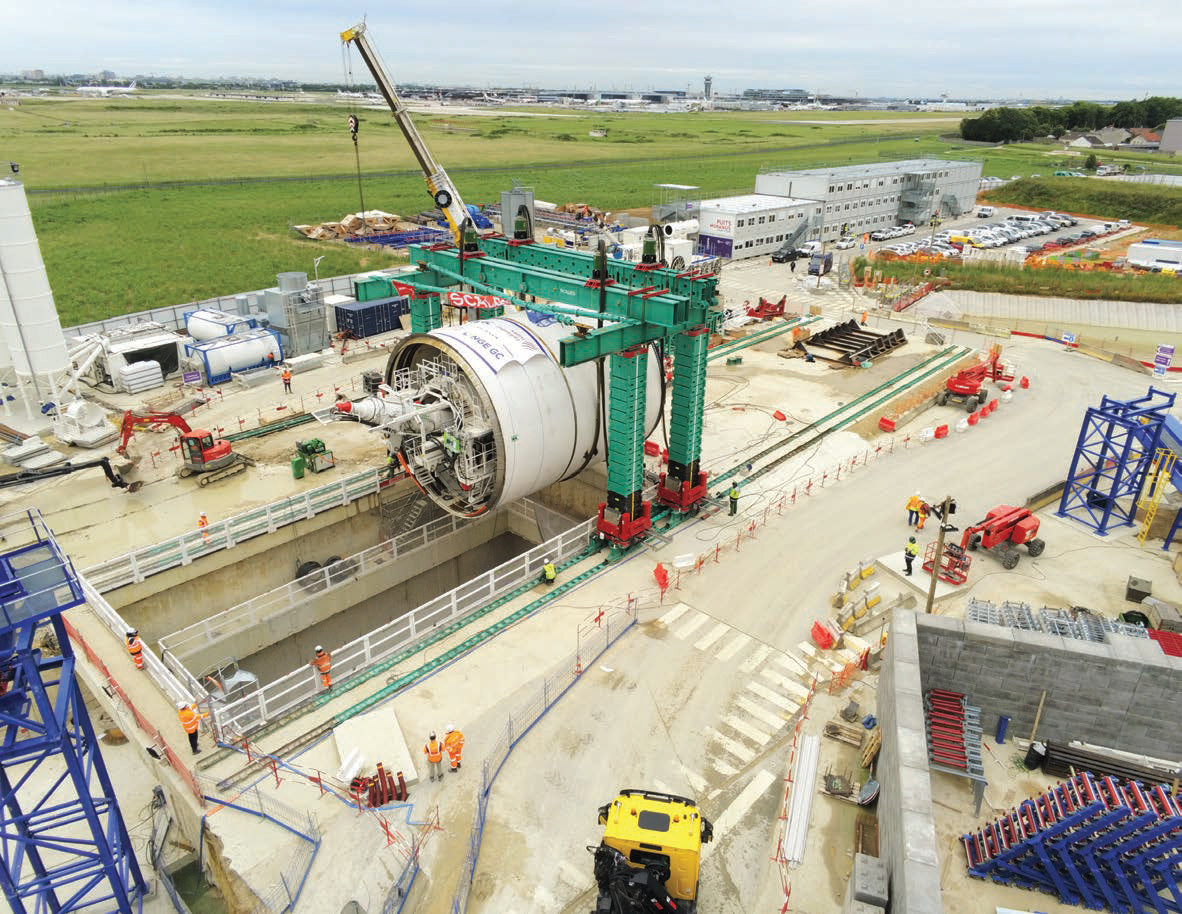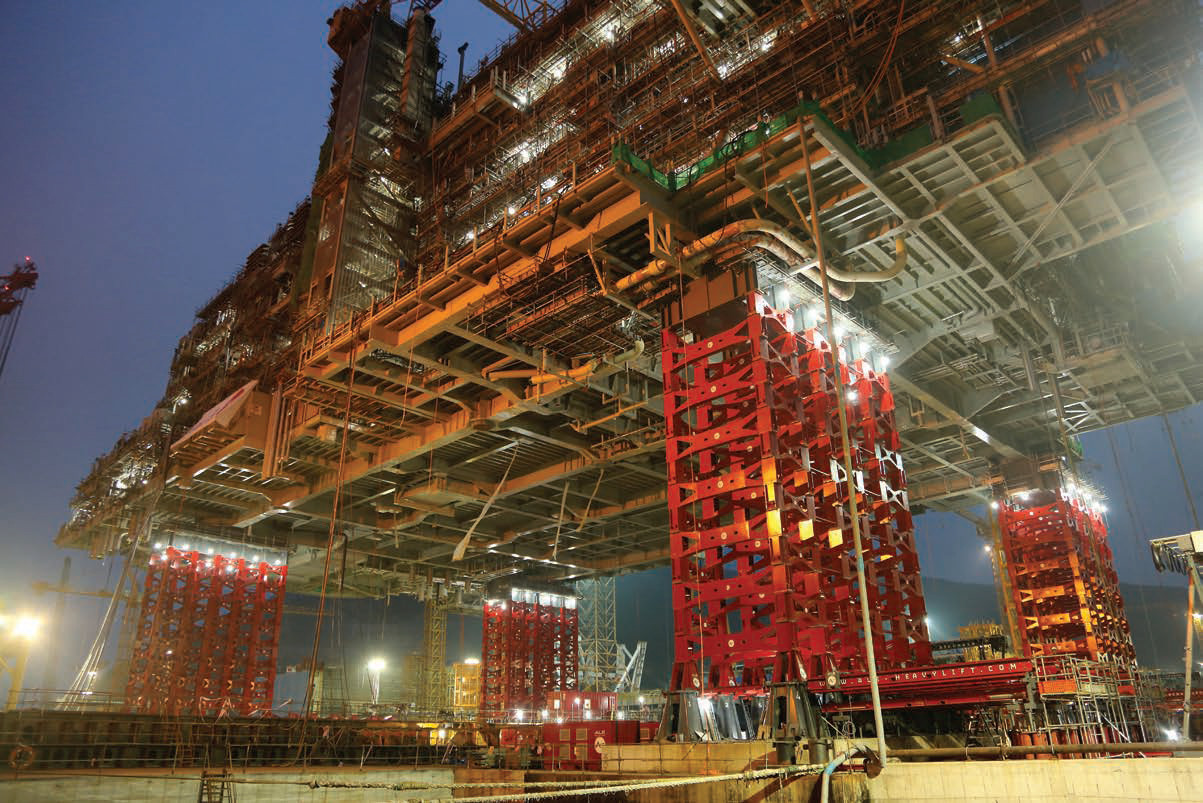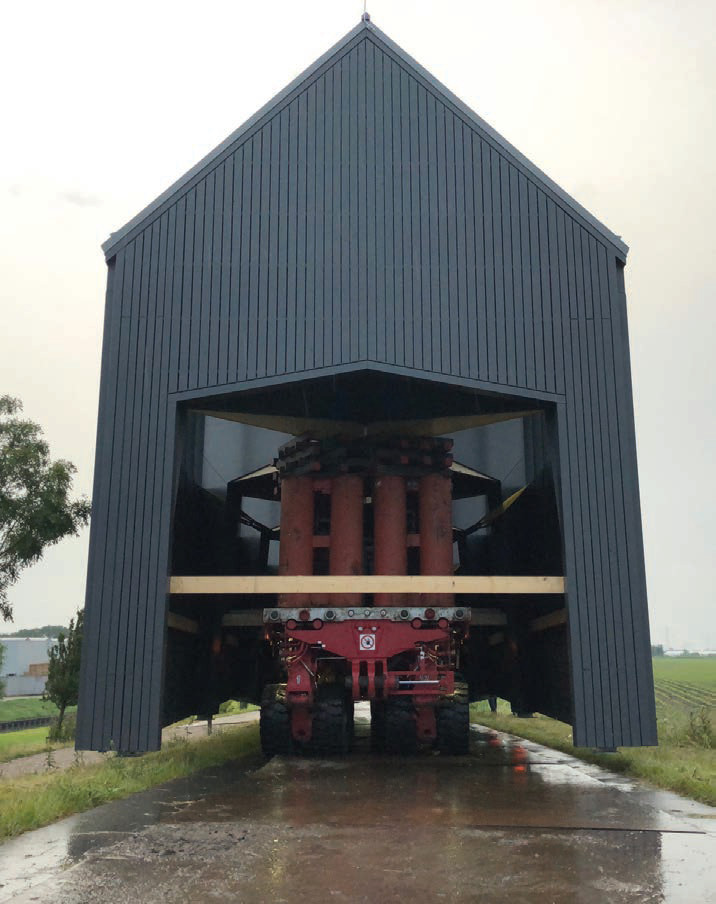New jack capacity
17 September 2019Hydraulic jacks can lift huge structures from below; strand jacks can lift them from above. Rams can push them sideways to slide along rails. Julian Champkin discovers that there is more than one way to move something heavy.
To lift a heavy object, use a crane. It seems rather obvious, but for really large and heavy objects cranes are not always a possible solution, and even if possible they may well be far from best. Large constructed units are frequently built as complete modules beside their eventual site, and call for alternative methods of lifting them into position – or more accurately, of moving them into position since lifting is not always involved. The default position is to think ‘use a crane’ but more imaginative engineering thinking may well come up with better solutions – more practical, more economic, easier and safer.
“What we are seeing is that design components in construction and engineering are getting larger and larger, and more and more complex to assemble,” says Pete Crisci, product line director for heavy lifting technology at Enerpac. “Roofs, for example, can now get built on the ground, with the expectation that they can then be lifted into place. Similarly with bridges: accelerated bridge construction builds the deck on the ground and then moves it into place as a complete unit. Oil and gas platform modules are becoming bigger too. Complexity of units is increasing, and schedules for assembling them become ever-more compressed. All that calls for alternative types of approaches for moving them.”
“For a lot of jobs hydraulic gantries, like our TLG 1000, are a good alternative to a crane," says Ronald Hoefmans, group technical director at ALE. “Another good solution is lifting a load by putting a jacking system underneath. The advantage of jacking is that there is no need for strong lifting points. The jacking system can be installed under the existing strong support points of a load. For some jobs in confined spaces a gantry with towers and strand jacks on top can be a good alternative.”
A strand jack has a wire rope running through it down to the load. The rope is clamped at the top of the jack, which extends hydraulically, raising the rope and its load. The rope is clamped into its new position while the piston returns to the bottom of its stroke, is re-clamped to the rope, and expands for another lifting cycle. “This approach may take less space than a crane. The disadvantage is that it can only lift one load from the position where it is installed. It cannot handle a number of loads, for example a series of columns spread over a big area in a refinery or similar facility, unless it is re-installed each time, which is inefficient.”
Several considerations will contribute to deciding which alternative method to use, says Hoefmans. “The number of lifts to be done, the availability of space on the site, the availability of equipment, and the cost will all be relevant.
“Strand jacks can lift hundreds of feet in the air, and are capable, in banks, of lifting thousands of tons,” says Enerpac’s Crisci. “Sliding with ram jacks can work well, but is incremental, in a series of stop-go motions.” It is an effective but by no means a new technology; Brunel launched the 19,000t SS Great Eastern in 1859 using hydraulic rams. But other methods can now also be used.
“Trolleys or electrically-powered wheels or rollers in a track give the advantage of continuous smooth motion, without stop-go, and are better for longer distances, such as at docksides or for some ship launches.”
The objects to be lifted are usually large, sometimes very large indeed; but their weight is not the only problem. “Tight spaces, headroom, and ground pressures and difficult ground are certainly significant, but there are also obstacles like environmental issues,” says Hoefmans. “For example, wind speed in the area of the lift, and operating temperature can be important.
“It is not always the heaviest lift which is the hardest,” he says. “Light lifts, such as exchanging a flare tip high up on an oil rig, can be challenging. A recent project of ours involved the lifting a 60t wooden bridge structure that due to its low weight and relatively high wind speeds needed to be lashed to an SPMT.
“There are often more solutions to solve a problem than the one used. In our world it is definitely needed to think out of the box to solve the clients’ problems in the most efficient, safe and costeffective way.”
“Cranes cannot always do the heavy loads required, and the headroom for a crane is not always present,” says Crisci. “Another consideration is that—on a crane lift—aligning bolt-holes is not easy.” Imagine a 500t oil platform module that needs to be manoeuvred to a few millimetres accuracy while it is swinging on the end of cables attached to a crane. “Jack-up systems, on the other hand, can lift tremendously heavy loads from underneath; and advances in digital sensors and control systems mean that they can now be synchronised much more easily and safely. You can manoeuvre 500t to within 40 thousandths of an inch, which is a millimetre. That accuracy is better than anyone actually needs.
“500t and upwards is the sweet spot for Enerpac. We do smaller lifts also, but higher weights are where the big benefits come. A large crane that can handle such weights is a big piece of kit. It is very expensive, and it can take weeks to move. Our equipment is compact. It fits on a truck. Think transport, think cost of ownership: that is when you start thinking of methods that are not cranes.”
Planning, of course, is everything. “It tends not to come in at the design stage: architects do not usually think about how to erect their buildings,” says Crisci. “It is the contractors who have to think about that. “
And they, if they are wise, start thinking about it early: “A project we were involved in was the new Nashville convention centre. It is a downtown congested site, with the roof built on the ground beside it. Most contractors bidding for the project planned on using cranes to lift the roof. One bidder talked to us and proposed using four 100t strand jacks. That avoided permit costs for cranes and was inexpensive in itself. That helped him win the bid.”
“On big projects we get involved in an early stage; the earlier the better really,” says Hoefmans of ALE. “Where required, we can develop bespoke equipment and solution to optimise a project for a client. For example, for our jack-up of the 42,695t topside for the Arkutun Dagi oilfield in South Korea, we were involved a few years before the jack-up. The client needed to know if there was a solution to jack the topside before they started the build. We developed the Mega Jack 5200 in response. We first got the order to build one prototype tower and proved it worked. After that, we got the go ahead to build the 12 towers used to jack up the topside.”
“A lot of the products we have developed have been in collaboration with contractors,” says Crisci, “to get a specific job done. Sometimes we customise, or we may develop a new product altogether. Strand jacks lifted the London Eye and the Las Vegas wheel. Dubai now has an observation wheel as well, the biggest in the world. We did a custom alternate lifting system to lift it, and its drive system with it.”
“We have done some very long bridges, for example the San Francisco Oakland Bay bridge. We did the Milau Viaduct in France, which is the tallest bridge in the word. The pylons are 800ft (240m) high; you cannot even get that high with a crane. The deck was built on the abutments and slid across the piers, using a system of wedges to lift, move and then set them down again and with temporary piers at mid-span to help support it.”
The lessons would seem to be: for heavy lifting, think outside the big, heavy, and possibly jacksupported box.
Enerpac Jack-up Gantry lowers Paris Metro tunnel-boring machine
In the latest phase of the Paris Metro extension project French heavy lift company Scales SAS used an Enerpac JS-250 jack-up gantry system to lift and lower a tunnel-boring machine weighing 880t.
Enerpac’s JS-Series is a synchronised lifting and lowering jacking system with self-contained hydraulics in each unit, designed to give uncluttered work areas.
Loads are lifted in increments, as steel boxes, called “barrels”, are stacked together to form lifting towers to mechanically hold the load. Computer controls give seamless and synchronous raising and lowering all towers simultaneously. Adjustable top barrels allow for adjustment to the starting height of the towers when ground conditions are not even.
The tunnelling machine, named ‘Koumba’ is 8.9m in diameter and 11.4m long. On the Metro lift a trolley system allowed the jackup to move the raised machine along a pre-laid track to its starting position.
Hydra-Slide skidding system replaces 500t heat exchanger
Hill Crane & Rigging (HCR) used a 500t-capacity heavy-track HT500 hydraulic skidding system from Hydra-Slide to replace a stacked heat exchanger at a refinery in Carson, California earlier this year.
The work covered the emergency removal of a 260,000lb (118t) heat exchanger and its replacement with a new unit of similar weight. Complications came from major obstructions on site, a tight schedule, and project delays caused by other contactors. Engineered 100t-capacity modular support stands and Hydra-Pac synchronous hydraulic power unit were used alongside the HT500.
The HT500 is designed as a cost-effective and accurate method of moving all types of heavy loads where a rigid load-carrying track is required. It has a total height of only 8in (200mm), which saves jacking time and makes the product suitable for use in confined spaces. With a standard double track layout it can push 500t and pull 250t.
“The side system was one of the major components of the heavyengineered concept that we pitched to the refinery,” said Darren Scruggs, senior account manager at HCR. “A jack-and-slide solution was the only viable option that did not involve removing overhead structure beams. We worked closely with Hydra-Slide to put together a robust proposal, and upon wining the contract we placed orders for the necessary equipment, which remains with our fleet.”
The work included transporting the old exchanger to its manufacturer, transporting the new 8m by 2.5m by 4.5m exchanger to the refinery, and final installation in the same position as the original. HRC also used a 500t capacity Enerpac gantry to load and unload the exchangers onto a dual lane, eight-line trailer. The project took five days to complete and was delivered on schedule.
“The existing exchanger was sitting on 4ft high concrete pedestals” said Michael Barry, general rigging superintendent at HCR. “We used crab stacks and pipe stands to support the slide track at the same elevation. We slide the exchangers a total distance of just short of 10m.”
Mammoet devises new skidding technique for bridge launch
Mammoet used a new method of skidding to position the St. Jacques road bridge in Montreal, Canada over a two-lane highway interchange.
To limit disruption to traffic the Ministry of Transport required the deck of the bridge to be built on a bank beside the site and then pushed at height across the highway. Mammoet’s skidding system usually consists of skid shoes placed in a skid track to move a load forward in a straight line. However, for the Montreal project it was not possible to use a skid track across the gap between the bearing points, because there was nothing but a void there, with the highway far beneath. So Mammoet engineers reinvented the way a skidding system works.
They designed a new system consisting of separate skid shoes that could operate independently of a skid track. The softwarecontrolled shoes worked as separate units programmed in a synchronized, four-step sequence to push the bridge out across the span, without continuously moving forward with the bridge.
Due to the weight of the St. Jacques bridge, Mammoet’s highest capacity shoes were required for the job. The new system was designed using Novarka skid shoes – tailormade 700t capacity skid shoes first used to slide the 36,200t concrete arch-shaped permanent containment structure over the Chernobyl reactor in the Ukraine. This was the largest land-based moveable structure ever built.
The bridge was launched in two phases. In the first phase, one half of the bridge was placed on a system of eight skid shoes and temporary supports. The system pushed the structure forward from the east side of St. Jacques Street using four steps. Vertical jacks lifted the bridge clear of the temporary supports and the skid shoes pushed it forward 0.6m. The jacks then lowered the bridge back onto the supports as the skid shoes retracted 0.6m to their starting point. Step-by-step, the system repeated the sequence until the bridge was pushed out over a 45m distance, at which point it was received by a middle pier between the highways. With their ability to side shift, the shoes could correct the path of the bridge if it went off centre.
In the second phase, the remaining half of the bridge was constructed on the east side and attached to the first section. The complete bridge was pushed out a further 66m until it completely spanned the highway below. This phase required 14 individual skid shoes operating on the eastern side of St. Jacques Street and an additional four on the middle pier. Mammoet completed the job by jacking the bridge down two meters onto its foundations.
The new skidding method enabled the client to launch the fabricated bridge within the congested site. As a result, the disruption to traffic was minimised to only two weekends and a few nights.
ALE strand jacks and skids widen bridge
ALE has used multiple installation techniques to install a bridge over the Virilla River in San José, Costa Rica. The bridge was installed alongside an existing one, to double the capacity of the crossing from two lanes to four.
The widening project also necessitated the adaption of the water drainage works and the installation of numerous auxiliary structures. ALE needed to work closely with the client to maintain a high level of coordination. This ensured the site was prepared for the installation stage of the project and that equipment could be installed.
ALE first tilted down one of the piles for the new bridge, weighing 90t, using two strand jacks units of 70t capacity. Both units were mounted on a frame to support the pile. The strand jacks were used to manoeuvre the pile until it reached the correct position.
Following this, ALE skidded the deck, weighing 200t, using 90t, 150t, and 300t skid shoes. The load was transferred along the abutment and supporting structure. ALE then jacked-down the pile and deck onto the bridge’s supports. Once in position, the client welded the pile to the lower surface of the deck.
This was repeated for the opposite pile and deck, with ALE completing the overall project in two months.